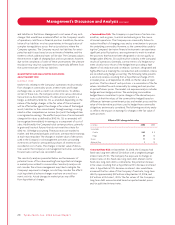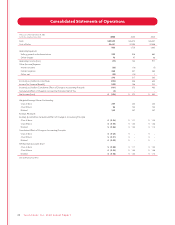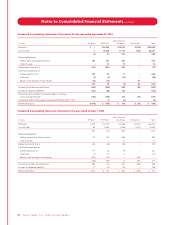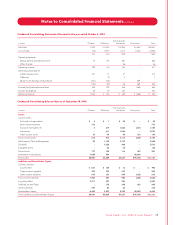Tyson Foods 2006 Annual Report Download - page 32
Download and view the complete annual report
Please find page 32 of the 2006 Tyson Foods annual report below. You can navigate through the pages in the report by either clicking on the pages listed below, or by using the keyword search tool below to find specific information within the annual report.
available at September 30, 2006, the Company expects an increase
in assets of $6 million, an increase in liabilities of $8 million and
an adjustment to accumulated other comprehensive income of
$2 million when it adopts SFAS No. 158.
In September 2006, the Securities and Exchange Commission
staff published Staff Accounting Bulletin No. 108, “Considering the
Effects of Prior Year Misstatements in Current Year Financial
Statements” (SAB 108). SAB 108 addresses quantifying the financial
statement effects of misstatements, specifically, how the effects
of prior year uncorrected errors must be considered in quantifying
misstatements in the current year financial statements. SAB 108 is
effective for fiscal years ending after November 15, 2006; therefore,
the Company expects to adopt SAB 108 at the end of fiscal 2007.
The Company is currently in the process of evaluating the
potential impact of SAB 108.
NOTE 2CHANGE IN ACCOUNTING PRINCIPLES
In December 2004, the FASB issued Statement of Financial Account-
ing Standards No. 123R, “Share-Based Payment” (SFAS No. 123R). The
pronouncement requires companies to measure and recognize com-
pensation expense for all share-based payments to employees,
including grants of employee stock options, restricted stock and
performance-based shares, in the financial statements based on the
fair value at the date of the grant. In the first quarter of fiscal 2006,
the Company adopted SFAS No. 123R using the modified prospec-
tive method. Under the modified prospective method, compensa-
tion cost is recognized for all share-based payments granted after
the adoption of SFAS No. 123R and for all awards granted to employees
prior to the adoption date of SFAS No. 123R that were unvested on
the adoption date. Accordingly, no restatements were made to
prior periods.
Prior to the adoption of SFAS No. 123R, the Company applied
Accounting Principles Board Opinion No. 25, “Accounting for Stock
Issued to Employees” in accounting for its employee stock compen-
sation plans. Accordingly, no compensation expense was recog-
nized for its stock option issuances, as stock options are issued
with an exercise price equal to the closing price at the date of
grant. Also, prior to the adoption of SFAS No. 123R, the Company
issued restricted stock and recorded the fair value of such awards
as deferred compensation amortized over the vesting period.
In March 2005, the FASB issued FIN 47, an interpretation of SFAS
No. 143. SFAS No. 143 was issued in June 2001 and requires an entity
to recognize the fair value of a liability for an asset retirement obli-
gation in the period in which it is incurred if a reasonable estimate
of fair value can be made. SFAS No. 143 applies to legal obligations
associated with the retirement of a tangible long-lived asset that
resulted from the acquisition, construction, development and/or
the normal operation of a long-lived asset. The associated asset
costs are capitalized as part of the carrying amount of the long-
lived asset. FIN 47 clarifies the term “conditional asset retirement
obligation” as used in SFAS No. 143, refers to a legal obligation to
perform an asset retirement activity in which the timing and/or
method of settlement are conditional on a future event that may
or may not be within the control of the entity. FIN 47 requires an
entity to recognize a liability for the fair value of a conditional
asset retirement obligation if the fair value of the liability can be
estimated reasonably. Uncertainty about the timing and/or method
of settlement of a conditional asset retirement obligation should
be factored into the measurement of the liability when sufficient
information exists. SFAS No. 143 acknowledges in some cases, suffi-
cient information may not be available to reasonably estimate the
fair value of an asset retirement obligation (ARO).
The Company adopted FIN 47 in the fourth quarter of fiscal 2006.
In connection with the adoption, an ARO liability of $12 million, a
related ARO asset of $3 million and a cumulative adjustment due
to change in accounting principle, net of tax of $5 million were
recorded. The ARO liability is included in Other Liabilities and
the ARO asset is included in Property, Plant and Equipment on
the Consolidated Balance Sheets at September 30, 2006.
The Company’s principal conditional asset retirement obligations
relate to the potential future closure, sale or other disposal of
certain production facilities. In connection with any such activity,
the Company is legally obligated under various federal, state and
local laws to properly retire the related wastewater treatment facility.
The pro forma impact on earnings before cumulative effect of
change in accounting principle, the related earnings per share
amounts and the asset retirement obligation, had FIN 47 been
applied to fiscal 2005 and 2004, were not material.
30 Ty s on Foods, Inc. 2006 Annual Report
Notes to Consolidated Financial Statements continued
























